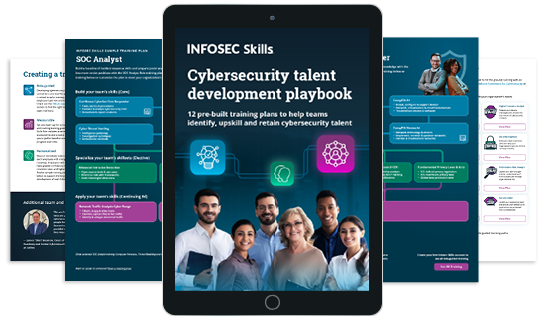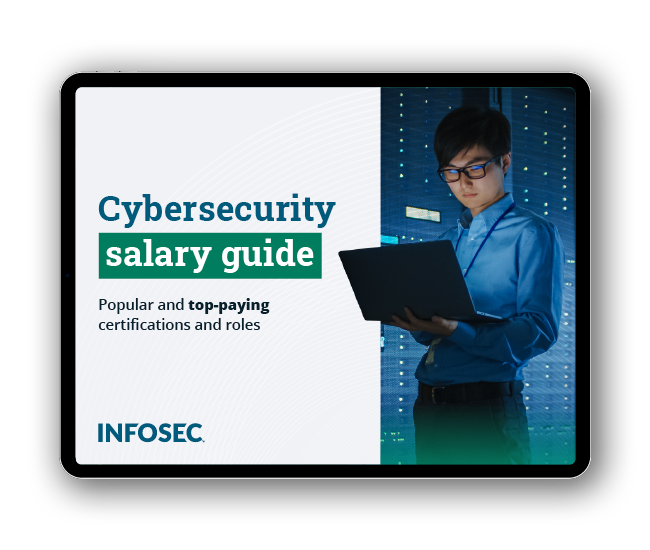CISM vs. CISSP: Which certification should you get? Your complete preparation guide
Cybersecurity professionals who want to develop their skills further or advance their careers can use certifications to streamline their progress. These certs help set you apart from other candidates for positions and provide concrete, objective evidence of your skills and experience.
The Certified Information Security Manager (CISM) and Certified Information Systems Security Professional (CISSP) certifications are two of the leading credentials employers look for while scanning resumes. Both provide demonstrable evidence of your abilities but have different focuses, so choosing between CISM vs. CISSP may depend on your career trajectory.
What should you learn next?

CISM and CISSP: An overview
The CISSP certification is designed for experienced professionals and demonstrates your knowledge of designing and managing access to IT systems. It involves developing protocols that keep unwanted visitors and hackers out while ensuring legitimate users have the accessibility they need to do their jobs or get the data they need.
To earn your CISSP certification, you need to answer questions regarding these following domains:
- Security and risk management
- Asset security
- Security architecture and engineering
- Communication and network security
- Identity and access management (IAM)
- Security assessment and testing
- Security operations
- Software development security
The CISM certification is designed for those with experience in information security management, and it focuses on skills you need to steer a department or company toward a more robust security posture. It covers the following four domains:
- Information security governance
- Information security risk management
- Information security program
- Incident management
ISC2 offers the CISSP certification, and ISACA provides the CISM. Both are vendor-neutral credentialing bodies; however, ISACA is focused on advancing digital trust through auditing, governance, risk and privacy management. ISC2 is dedicated to training cybersecurity professionals.
When it comes to validating your cybersecurity knowledge and skills, CISSP and CISM can be invaluable tools because they provide evidence from a neutral certifying body. Even testimonies from former and current employers could be biased — either for or against you. But because these certs come from organizations dedicated to supporting the cybersecurity industry, they give you the kind of evidence many employers rely on.
Key differences between CISM and CISSP
The CISSP and CISM are different in both their subject matter and the kinds of careers they’re designed to support. Here are some of their key differences:
- The CISM has more of a management focus than the CISSP
- The CISSP covers a broader range of technical subject matter
- The CISM is more designed for enterprise-level use cases
If, for instance, you want a certification that demonstrates a wider range of general cybersecurity knowledge, you may prefer the CISSP over the CISM because it touches on more topics. On the other hand, if your career path includes managing incident response teams or developing overarching security programs, the CISM may be a stronger option.
The certifications have slightly different prerequisites and exam formats as well. For the CISM requirements, you need at least five years of experience in information security management, and you need to verify that you have this experience. You also have to apply for your certification within five years after passing the exam.
The CISSP also requires five years of experience. This includes full-time experience in at least two of the eight domains. You can use a bachelor’s or master’s degree in computer science, IT or a related field to satisfy as much as one year of the experiential requirement. You can also use another credential that the ISC2 approves to satisfy another year of required experience. You can find the complete list of certifications you can use on ISC2’s website, but they include popular certs like CompTIA Security+ and AWS Certified Security - Specialty. You can also use part-time work or an internship to meet the requirements.
The exam formats are similar in that they both take around four hours to complete and consist of multiple-choice questions. The CISSP also has advanced innovative prompts. The number of questions for the CISSP can be between 100 and 150, while the CISM has 150 questions.
The CISM has fewer domains than the CISSP, but there are some similarities. For instance, both touch on topics about securing digital assets and security and risk management. However, the CISSP gets more specific with some elements of security. For example, it specifically addresses software development security, while the CISM focuses on higher-level, managerial topics such as enterprise-wide governance solutions.
What should you learn next?

Career paths and opportunities
The CISM is most valuable for professionals who want to oversee an IT security team. It focuses on general issues that IT teams often have to tackle, such as incident response.
The CISSP is also valuable for those who want to run IT teams, but it’s more designed to prove that you have the technical knowledge necessary to know what to look for in security solutions. For instance, the CISSP has a domain that focuses solely on identity and access management (IAM). Therefore, a passing score implies that you know what an effective IAM solution looks like, which protocols work best and how to choose the best infrastructure depending on network architecture. This makes the CISSP a better choice for those seeking more specialized roles, such as an IAM administrator or architect.
The CISM, on the other hand, would be a more ideal fit for someone looking to specialize in implementing and managing a specific kind of IT solution. For example, it would be a great fit for someone who has to evaluate and quantify the cybersecurity risk profile of an enterprise. A CISM-certified professional may be qualified to run a team that analyzes a company’s network infrastructure and assets and their vulnerabilities — considering the kinds of attacks organizations in that industry are most likely to face.
The average CISM salary, according to Infosec analysis, is $156,420 per year, whereas the CISSP average salary comes in around $151,860. However, those are averages, and it should be noted that there is a large range of salary potential based on various factors.
The amount you make depends on your employer, location and years of experience, but generally, these jobs have been trending well in demand, making them sound employment choices. The increase in cyberattacks and threat vectors has underscored the need for cyber defenders who have the certification to prove their value.
Making the decision: CISM or CISSP?
Your professional background is one of the prime factors when choosing between the CISSP and CISM. While both require you to have at least five years of experience in the field, the CISSP requires your experience to be specifically related to one of its current domains.
Also, you can use certifications you already have to satisfy the CISSP’s prerequisites. So, if you only have four years of experience, for example, but you also have your CompTIA Security+ cert, you can qualify to sit the CISM exam.
Your career goals are another factor to consider. If you want to manage a team of individuals, the CISM may be a more ideal fit. On the other hand, if you want to qualify for a specific technical discipline, such as a security architect, you may be better off getting your CISSP.
If you’re considering moving into cybersecurity from another related field, such as general IT or management, it may be a little easier to qualify for the CISSP. The CISM requires five years of specific experience in information security management. With the CISSP, however, you can use an IT degree to satisfy at least some of the experiential requirements. It may be a good idea to start working with at least some element of information security now so you can fulfill the experiential requirements for both certs as soon as possible.
Complementing CISM and CISSP with other certifications
You have a range of choices when it comes to complementing your CISM or CISSP with an additional certification to prove your qualifications. For instance, you could use:
- Cloud security certifications, such as CSSP, AWS and Azure certifications to demonstrate proficiency in securing cloud architectures
- Privacy management certifications, such as IAPP, which focus on ensuring the privacy of the public’s data, as well as that of private organizations
- Risk and governance certifications, such as CRISC or CGEIT, to show you know how to conform to regulatory and internal risk mitigation requirements
- CASP+, particularly if you seek a more technical, less managerial role, such as a risk management specialist
Regardless of which certification you choose — or which ones you get to augment your CISSP or CISM — it’s important to continually learn new skills and renew your certifications. Since cybersecurity changes so frequently and rapidly, it can be easy to lose track of the latest techniques and technologies. For instance, ransomware-as-a-service attacks have recently risen, so understanding how to prevent assaults from relatively inexperienced yet very well-equipped attackers is more important now than ever.
You also need to stay up to date by earning continuing professional education (CPE) credits and paying any necessary dues your certifying body requires. For example, to maintain your CISSP, you need to earn 120 CPE credits over three years.
Get your guide to the top-paying certifications
With more than 448,000 U.S. cybersecurity job openings annually, get answers to all your cybersecurity salary questions with our free ebook!
CISM versus CISSP
Choosing between the CISM and CISSP comes down to your career path and background. Those in the hunt for a managerial position may lean more towards the CISM, and those looking to verify a more specific technical skill may want to consider getting their CISSP.
Either way, your first step is to assess your career goals and see which certification is the best fit. Next, you’ll want to consider the best ways to prepare for the exam, such as a CISSP Boot Camp or CISM Boot Camp, which gives you an immersive, comprehensive preparation program.
FAQs What are the main differences in exam content and format between CISM and CISSP?
The main differences are the CISM requires you to answer 150 questions while the CISSP requires you to answer between 100 and 150. Also, the CISSP has more specific technical topics than the CISM.
Can I hold both CISM and CISSP certifications, and is it beneficial?
Yes, you can hold both the CISM and CISSP. This can be beneficial because an employer may prefer one over the other, so by holding both, you do a better job of covering your bases.
How do CISM and CISSP certifications impact salary and job prospects in cybersecurity?
The CISM and CISSP can result in higher salaries and better job prospects because in cybersecurity, “talk is cheap,” as the saying goes. A certification provides concrete evidence that you have what it takes to meet or exceed an employer’s expectations.


